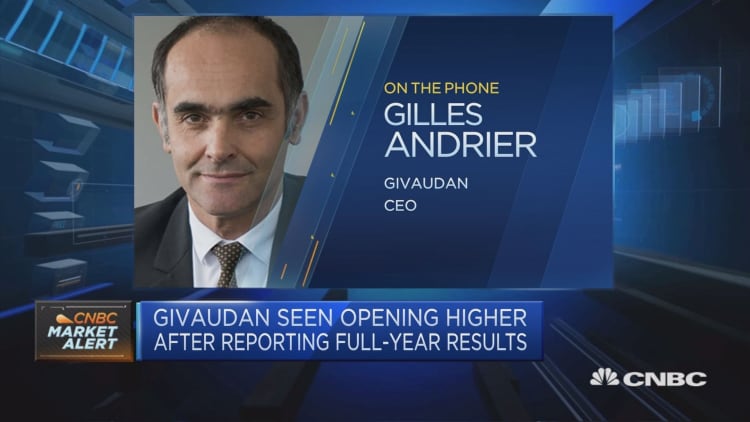Signs that the bull market in stocks has gone global for good are everywhere.
Harvard economics professor Kenneth Rogoff said this week that right now "is the best moment in the global economy since the '50s."
As of Friday, more than $61 billion had flowed into the U.S. ETF industry, which would smash the monthly record set after Trump's election. And a lot of that action continues to be U.S. stock bets.
But in January there also have been massive flows into developed markets and emerging markets equity ETFs and traditional global mutual funds, according to preliminary TrimTabs data for the month. Inflows of near-$30 billion into overseas ETFs puts it on pace for the second-highest month in two-and-a-half years. In traditional mutual funds, the roughly $15 billion into global portfolios in January is the most since July 2015.
By many technical and sentiment indicators, all this market buying is signaling "Sell!" — whether it be a sell on stocks or a sell on bonds.
"People are just embracing risks," said Winston Chua, TrimTabs analyst.
People are also chasing performance. Last year overseas markets, both in the developed world and emerging world, did better than the S&P 500.
But wealthier investors who manage their own market money are also showing a subtle focus on valuation that's leading them to like overseas stocks, according to the results of an E-Trade Financial survey.
Ninety-one percent of investors who have more than $1 million in brokerage accounts rated the U.S. economy at an A or B in the first quarter, the highest level ever recorded by the E-Trade survey, provided exclusively to CNBC. The percentage of these investors who grade the U.S. economy at an A increased from 8 percent in the fourth quarter last year to 24 percent in January. Eighty-one percent also think the economy is healthy enough for additional Fed rate hikes, up from 67 percent in Q4 2017.
But the percentage of these investors who are bullish on U.S. stocks actually declined slightly. And these investors say they are much more likely to invest overseas this year.
There's performance-chasing, too, but this is a trend breaking from the post-2009 stock market run. It's reminded people there is a whole other world out there. Half of the global equity market cap is outside the U.S., and it looks more compelling on a valuation basis.Mike Loewengartvice president of investment strategy at E-Trade Financial
Last quarter just about half (51 percent) of these investors said international markets looked attractive to them. This quarter, 67 percent of these same million-dollar account investors told E-Trade that overseas equities look attractive. Conversely, the percentage of investors who said international was not attractive to them was cut in half quarter over quarter, from 22 percent in Q4 2017 to 11 percent now.
"The opportunities overseas are primarily driven by a valuation perspective," said Mike Loewengart, vice president of investment strategy at E-Trade. While overseas stocks boomed in 2017, "they didn't have the run U.S. stocks had out of the crisis," he said.
"There's performance-chasing, too, but this is a trend breaking from the post-2009 stock market run," Loewengart said. "It's reminded people there is a whole other world out there. Half of the global equity market cap is outside the U.S., and it looks more compelling on a valuation basis," he said.

TrimTabs data shows that flows have been especially strong this year into emerging markets and Asian equities. E-Trade said the trading it has seen backs that up, too.
Year-to-date through Thursday, the iShares Core Emerging Markets ETF (IEMG) is behind only the S&P 500 in flows with near-$3 billion, while iShares MSCI Japan (EWJ) has taken in more than $2 billion, making it the only country fund in the top 20 among all ETFs, according to data from XTF.com. The iShares Core MSCI EAFE (IEFA) is also in the top five among all ETFs.
Emerging markets are again outperforming the U.S. stock market at the beginning of 2018, by several percentage points.
"Fresh cash continues to find its way into Asia and emerging markets amid the global stock market rally and a weakening U.S. dollar," Chua said. TrimTabs data shows that China, Japan and emerging markets-focused equity ETFs all have pulled in more than 3 percent of their total assets this month.
China has by far been the most popular region. China equity ETFs have issued $1 billion (4.9% of assets) month-to-date, and they have had inflows on every trading day for four consecutive weeks. This month's inflow is on track to be the most since May 2015, when they hauled in $1.4 billion (5.8 percent of assets).
"These funds are up a staggering 9.6 percent this month alone, making them the second best-performing category behind Latin America," Chua noted. Brazil ETFs have been surging since a court decided to uphold the conviction against former President Luiz Inacio Lula da Silva.
Asian equity bets leading the way
| ETFs | January flows | % of assets | December flows | % of assets |
|---|---|---|---|---|
| EM | $6.4B | 3.20% | $2.1B | 1.20% |
| China | $1B | 4.90% | $600M | 3.50% |
| Japan | $1.4B | 3.70% | $500M | 1.50% |
| Europe | $700M | 1.10% | (-$950M) | 1.6% outflows |
Source: Trimtabs, January flows data through 1/26
This finer lens on stock valuation is also playing out within the million-dollar brokerage account holders U.S. stock positioning in January. Health care is the sector that most (53%) of these investors say has the most potential this quarter. It's the only sector that received that vote of confidence from a majority of the investors, followed by tech (47%), financials (46%) and energy (44%).
Health-care stocks are less richly valued on a forward price-to-earnings ratio, according to stats updated by Yardeni Research this week, though they aren't the cheapest S&P 500 sectors on a forward P/E basis. The real dogs, telecom and utilities, have lower P/Es, as do financials.
Loewengart said the interest in health care is likely due to the sector not having had quite as good a run as some other popular U.S. stock sectors in the past few years, leaving valuations "slightly more attractive." He also noted that some investors may be making a post-tax cut trade on health care and the opportunity for big drug companies to repatriate cash held overseas as well as a pickup in cross-border M&A as a result of the tax deal. Health care also tends to be a little more defensive than other S&P 500 sectors, meaning less volatile if the entire market were to fall.
As of Friday, health care was the best-performing sector in the U.S. market, with a return of over 10.6 percent year-to-date.
Note on the survey: The E-Trade survey was conducted from January 1 to January 15, 2018, among an online US sample of 923 self-directed active investors who manage at least $10,000 in an online brokerage account. For CNBC, a subset of investors who manage at least $1 million in assets is compiled.





